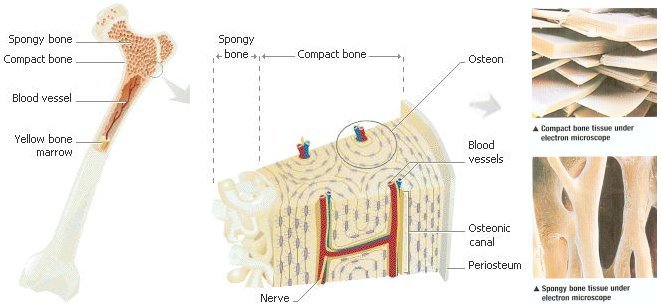

| Home Page | Overview | Site Map | Index | Appendix | Illustration | About | Contact | Update | FAQ |
 |
 |
Vertebrates are segmented chordates in which the notochord is replaced in the adult by a vertebral column composed of individual vertebrae. The skeleton is internal, and in all the vertebrates, there is not only a backbone but also a skull, or cranium, to enclose and to protect the brain. In higher vertebrates, other parts of the skeleton serve as attachment for muscles and for protection of internal organs of the thoracic cavity and the abdomen. Movements are provided by muscles attached to the endoskeleton. All but the fishes are tetrapods, meaning that they have four limbs. General body plan consists of head, trunk, two pairs of appendages, and a postanal tail (these structures are highly modified in many vertebrates and sometimes absent). There is a fundamental design in the skeleton of all vertebrates. Humans, |
Figure 27a Orthopedics |
Figure 27b Limbs |
bats, lizards, and whales are all just variations on a theme (see for example the common pattern of limbs for some vertebrates in Figure 27b). |
 |
Bone is the major component of the skeletons in adult vertebrates. It is composed of both living tissues, such as bone cells, fat cells, and blood vessels, and nonliving materials (such as collagen) secreted by the bone cells called osteoblasts into the inter-cellular space. The collagen fibers are coated with a calcium phosphate salt, making it strong without being brittle. As shown in Figure 27c, a bone can be divided into four parts: |
Figure 27c Bone Structure |
1. Periosteum - This fibrous membrane is the outer layer of the bone. It is rich with blood vessels and nerve endings and it ends at the edge of the joint area or where the ligaments and the tendons insert themselves. |
 |
An important contribution to the shape of animals with backbones is the number of vertebrae (bones in spinal column) that make up the structure. While human has 33, snakes have more than 300, with some species having more than 500. Vertebrae develop from segments of tissue called somites, which form, one after another, in a head-to-tail sequence in the embryo (diagram a, Figure 27d). They bud off from the "head" end of the presomitic mesoderm (PSM), an immature tissue fated to generate the somites. This budding is regulated by a "clock-and-wavefront" model. In snakes, the clock genes seems to express 4 times faster than in shorter-bodies animal (such as mice), leading to many more, though smaller, somites (see diagram b in Figure 27d). |
Figure 27d Somitogenesis [view large image] |
Table 06a below lists some Orthopedic specialities for bone healing. |
| Disease | Symptom(s) | Cause(s) | Treatment(s) |
|---|---|---|---|
| ACL Injury, Sprains, Strains | Instability in the knee (ACL), pain, swelling, bruising, inflammation | Tear in knee ligament (ACL), generally in ligaments and tendons | Physical Rehabilitation, surgery; Rest, Ice, Compression, Elevation (RICE)( see link) see link) |
| Bone Fracture | Swelling, deformity, pain, loss of function, protruding bone | High impact, medical conditions | Pain management, immobilization with cast, surgery ( see link) see link) |
| Bone Tumor | Painless mass, Pain, fatigue, fever, weight loss, anemia, unexplained bone fractures | Benign tumors, cancerous growth | Medication, chemotherapy, radiotherapy, surgery (  see link) see link) |
| Concussion | Headache, confusion, amnesia, dizziness, nausea, vomiting, slurred speech, fatigue | Traumatic brain injury | Rest (physical and mental) (  see link) see link) |
| Elbow Injury | Elbow Deformity, protruding bone | Inflammation or injury to the tendons that attach muscle to bone | Rest, ice (20 mins, 3 times/day), compression with bandage, Elevating arm ( see link) see link) |
| Frozen (Fifty) Shoulder | Chronic shoulder pain with limitation of movement | Adhesive capsulitis of the shoulder joint often associated with ageing ( > 50 years old) | Medication, prolotherapy, prescribed exercises (  see link) see link) |
| Herniated Disk | Arm or leg pain, numbness or tingling, muscle weakness | Slipped or ruptured cushion disk between the vertebrae compressing the nerves | Medications, therapy, surgery (  see link) see link) |
| Muscular Dystrophy | Frequent falls, trouble with movement, waddling gait, walking on toes, large calf muscles, learning disabilities | Abnormal genes in X-chromosome interfere with the production of healthy muscle | No cure, some relief by medications, therapy, surgery (  see link) see link) |
| Osteoporosis | Back pain, loss of height, stooped posture, easy bone fracture | Rate of bone mass loss exceeds replacement | Medications (  see link) see link) |
| Whiplash | Neck pain, stiffness, headaches, numbness in the arms, fatigue, dizziness | Neck injury due to forceful, rapid back-and-forth movement | Rest, medications, exercise, physical therapy ( see link) see link) |
 |
 |
Both are composed of living cells that maintain a non living matrix. Obviously, the sharks evolved along a slightly different path than the bony fish. They solved the buoyancy problem (in water) with lightweight skeleton, while the bony fish developed swim bladder and can afford to bear heavier skeleton. |
Figure 27e Skeleton of Fish and Shark [view large image] |
Figure 27f |
A 2014 Nature article about the genome of Elephant Shark (Figure 27f) reveals that it is the absence of a single gene family that inhibits the turning of cartilage into bone. |